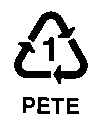
Guide to storage productsdigital museum of collecting
|
Collecting: Products: People: Brands: Guide: |
|
|
cellophane - Invented by a Swiss chemist in 1900 by disolving cellulose (tree bark, etc.) to make a thin, transparent sheet that does not absorb water, oil or grease and keeps an air-tight seal.
|
|
 |
|
> top |
|
|
|
 |
|
|
 |
polypropylene (PP) polymers of propylene
|
> top
|
 |
polystyrene (PS)
|
|
 |
"vinyl" (V) also known as polyvinyl chloride (PVC)
|
|
References:Library of Congress for archival product Specifications, and a good FAQ about preservation of works of art on paper. Caring for your Documents and Works of Art on Paper from The American Institute for Conservation of Historic & Artistic Works. HTML version in English, and in Spanish or download the colorful PDF file (Adobe Acrobat). The American Plastics Council is a great source of information for "end-users" of plastic products, presented in simple language. Educational material includes the very informative Introduction to Plastics: Background Information for Teachers. Read the document in your browser window [HTML format] or download the large 1.9 MB [PDF format] for Adobe Acrobat. This illustrated document includes a chapter about "Common Plastic Resins Used in Packaging" with the best description of the 7 different plastics represented by the "chasing arrow" recycling symbols. Many other resources on the general history of plastics, a simple chart of plastic properties and applications, and a good historical article from Newsweek Magazine. More history of plastics from the society of the plastics industry and technical definitions of plastic resins. Download small 11KB PDF files for each of the seven recycling symbols: (PET) (HDPE) (V) (LDPE) (PP) (PS) (OTHER) Mylar® and Melinex® polyester film, only by DuPont Teijin Films. (go to Products and Technology tab and find Mylar in the left column . Compete technical data - "Celebrating 50 years") A beautiful splash screen with dotsfrom NAPCOR, with specific information about PET and free samples.
|
> top |
|
| 6.2 n© November 2010, created: 30 August 2003 |